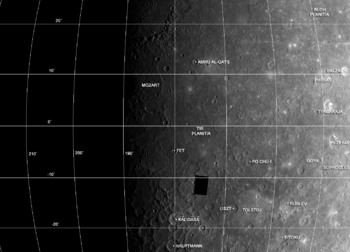Tolstoj (Mercury Crater)
| Tolstoy | |
|---|---|
 The Tolstoy crater (bottom right in the picture), photographed by the Mariner 10 spacecraft |
|
| properties | |
| width | 16 ° 18′S / 16.3 ° S |
| length | 163 ° 30′W / 163.5 ° W |
| diameter | 390 km |
| depth | unknown |
| Eponym | Lev Nikolayevich Tolstoy |
Tolstoj is a large, very old impact crater on the -15. Latitude and 165th longitude of the planet Mercury . It was named after Lev Tolstoy . The albedo feature Solitudo Maiae appears to be associated with this crater.
The impact that caused the Tolstoy Basin occurred very early in the history of Mercury. Two jagged interrupted rings, estimated at 356 km and 510 km in diameter, encircle the structure but are not very pronounced on the north and northeast sides; a third incomplete ring, 466 km in diameter, occurs on the southeast side. Scattered spots with darker albedo lie outside the innermost ring. The central part of the basin is covered with evenly planar material. Hapke and others have suggested that the dark albedo materials associated with the edges of the Tolstoy Basin are noticeably more indistinct than the surrounding terrain, while the plains present in the basin are noticeably redder in color.
Despite Tolstoy's advanced age and the formation of a cove in its older inner planes, it received a well-defined and astonishingly well-preserved, radial ejecta cover around two thirds of its circumference. The ejecta tends to block and is only slightly linear between the inner and outer rings. Circular line formations with a slightly swirl-shaped pattern can best be seen on the southwestern side of Tolstoy. The ejecta's unusual straight-line pattern suggests the following:
- Control of the ejecta pattern of structures that were present before the basin formation,
- preferably fires while the structural development of originally symmetrical ejecta blanket of the layer material inside the crater or
- Formation of Tolstoy by an oblique impact from the northwest, which caused an ejecta blanket with bilateral symmetry and little or no impact uprange. An analysis of the stereo photographs of the Tolstoy ejecta northeast of the crater leads to the assumption that this deposit was upwarped to a higher altitude relative to the surrounding plains.
See also
swell
- ↑ Davies, ME, Dwornik, SE, Gault, DE, and Strom, RG, 1978, Atlas of Mercury: National Aeronautics and Space Administration Special Publication SP-423, 128 p.
- ↑ Hapke, Bruce, Danielson, GE, Jr., Klaasen, Kenneth, and Wilson, Lionel, 1975, Photometric observations of Mercury from Mariner 10, 1975: Journal of Geophysical Research v. 80, no.17, p. 2431-2443.
- Gerald G. Schaber, John F. McCauley: Geologic Map Of The Tolstoj (H-8) Quadrangle Of Mercury (PDF; 292 kB) 1980. Accessed February 25, 2011. Prepared for the National Aeronautics and Space Administration by the US Department of the Interior, US Geological Survey. Published in hardcopy as USGS Miscellaneous Investigations Series Map I-1199, as part of the Atlas of Mercury, 1: 5,000,000 Geologic Series. Hardcopy is available for sale from US Geological Survey, Information Services, Box 25286, Federal Center, Denver, CO 80225)
Web links
- Tolstoj quadrangle maps (English)